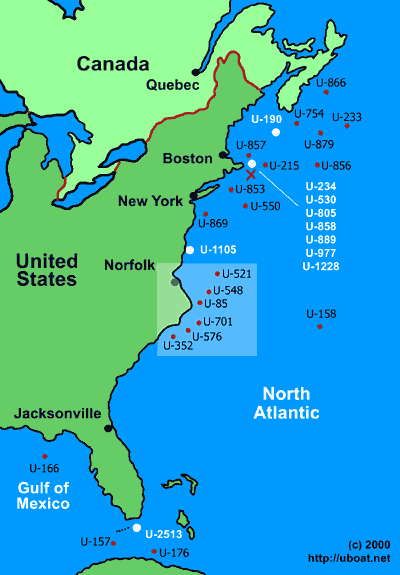![]()
What follows is an article that I excerpted from my copy of the "V-MAIL" section of the News from the National WW II Museum and I am afraid many Americans have no idea of this happening on our shores.''
Quote:--
"Most people think of the U-Boat as only being a highly efficient ship-killer, but it also supported espionage, intelligence gathering and sabotage operations throughout the war. These missions were carried out at points throughout Europe, on the coast of Africa , within the Artic Circle and even in America. Before the end of the war, U-Boats made landings In North America on six separate occasions.
The first landing occurred on May 14,1942, when U-213 put Abwehr agent Alfred Langbein ashore near the village of Saint John on the Bay of Fundy coast of New Brunswick. Langhein spent the next two years in hiding without doing any spying at all before finally turning himself in to Canadian Naval Intelligence in Ottawa in September 1944.
Before dawn on June 13, U-202 put four saboteurs ashore near the village of Amagansett, Long Island as a part pf Operation Pastorius. Three nights late U-584 landed another group of four saboteurs near Point Vedera Beach, Florida. The two groups were to use explosives to destroy railroad bridges, defense plants and factories crucial to U.S military aircraft production. The Long Island group made their way to New York City where the team leader George John Dasch decided to turn himself in. Because of his cooperation the FBI was able to round-up the remaining saboteurs. All eight men were convicted of espionage by a military tribunal in Washington,DC.. Six were electrocuted by electric chair on August 8, 1942. The other two were ultimately deported back to Germany in 1948.
The fourth landing occurred during the night of November 9, 1942 when U-518 surfaced in Chaleur Bay in Eastern Quebec and put Abwehr agent Werner von Janowski ashore near the village of New Carlisle. With his unusual clothing and foreign accent, Janowski stood out among the Quebecois like a sore thumb, resulting in his arrest by Royal Canadian Mounted Police the next day.
The fifth ad perhaps most interesting landing began early in the evening of October 22, 1943, when U-537 anchored in Martin Bay just south of Cape Chidley on Canada's Labrador Coast. The following morning, personnel from the U-Boat assembled an automated weather station on a hill overlooking the bay. The station functioned for only a day before mysteriously falling silent.
The final North American landing occurred when U-1230 put ashore Abwehr agents Erich Gimpel and William Curtis Colepaugh at Hancock Point on Frenchman's Bay, Maine shortly after midnight on November 30, 1944. Gimpel and Colepaugh were given the ambitious task of infiltrating the aviation industry and the Manhattan Project. The agents made their way to Portland, Maine and then to New York City where Colepaugh lost his nerve and turned himself in to the FBI. Gimpel was arrested soon thereafter bringing Germany's final attempt at espionage in North America to an unsuccessful conclusion". End Quote
I am also aware of a couple other atures of saboteurs not chronicled here
Top/Sgtleo 
![]()







